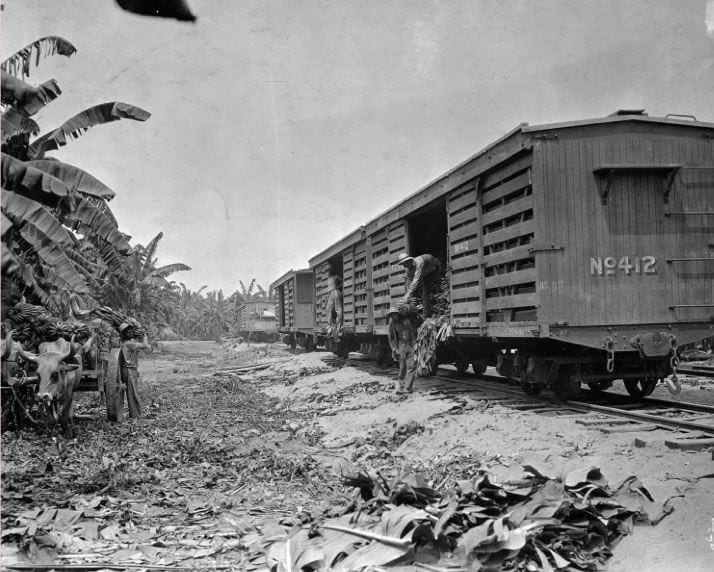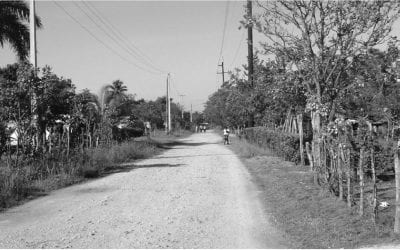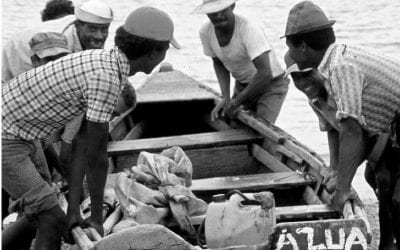Making A Difference: Repatriating Photographs

Loading fruit, zacapa, Colombia, April 12, 1927. Photo courtesy of Baker Library Historical Collections, Harvard Business School
I first learned of the United Fruit Company’s operations in Colombia, like many people, when I read Gabriel García Márquez’s 100 Years of Solitude and its description of the 1928 massacre of banana workers in Santa Marta. A few years later, I was researching United Fruit for my dissertation, and was met with a wall of silence when I tried to contact the company to gain access to its records. Several other scholars including Philippe Bourgois, Marcelo Bucheli, and Jorge Giovannetti, have managed to access UFCO papers in scattered locations (in Panama, Colombia, and Cuba, respectively). But company headquarters insist that the records have been officially destroyed and are not available to scholars.
There is one repository, though, that is open to scholars and that has been used by many of us who have researched United Fruit over the years: the photograph collection at the Baker Library at the Harvard Business School. When I was writing my chapter on the Colombian banana industry for Linked Labor Histories: New England, Colombia, and the Making of a Global Working Class, I spent some time going through the Colombia albums in the collection, and chose an arresting photograph of what the company photographer identified as a “native family” in the banana zone to include in my book. I loved the image so much that I hung a framed copy in my house.
In the fall of 2007 I hosted a Colombian union leader from Santa Marta on tour in Boston, and I showed him the photograph, and told him about the collection. “You know, those belong to us,” he told me quietly. His words stayed with me over the past year.
2008 marks the 80th anniversary of the 1928 massacre, and on December 5. I attended a conference at The University of Magdalena to commemorate the anniversary of the massacre. While working on my conference paper, the union leader’s words continued to haunt me. I finally contacted librarian Laura Linard at the Baker. Would the library be interested, I wondered, in sharing some of its images with the University of Magdalena, in a sense, returning the photographs to the place and people that they came from?
With the collaboration of DRCLAS and the Baker Library, we selected 28 images from the UFCO collection Colombia albums. Some of the photographs show the company’s operations and facilities, some show the workers, and some show the results of the 1928 strike, uprising and massacre. Many company buildings were destroyed during the conflict, and the destruction was meticulously documented.
I arranged to give the photographs as a gift from DRCLAS and the Baker Library at the anniversary conference in Santa Marta. I am extremely grateful to be able to play a small role in restoring a slice of history to a region that provided so much wealth, and so many bananas, to my native Boston.
Related Articles
Editor’s Letter: The Sixties
When I first started working on this ReVista issue on Colombia, I thought of dedicating it to the memory of someone who had died. Murdered newspaper editor Guillermo Cano had been my entrée into Colombia when I won an Inter American Press Association fellowship in 1977. Others—journalist Penny Lernoux and photographer Richard Cross—had also committed much of their lives to Colombia, although their untimely deaths were …
The True Impact of the Peace Corps: Returning from the Dominican Republic ’03-’05
I am an RPCV: a Returned Peace Corps Volunteer. For me the Peace Corps was an intense life experience, above anything else. As I continue to reflect on it, I am struck with the many and varied ways in which it continues to affect my life. As a PCV in the Dominican Republic from September 2003 to November 2005, I lived, worked, and learned in a small sugar cane-dependent community two hours outside of Santo Domingo…
In the Shadow of JFK: One Peace Corps Experience
I am often asked about the Peace Corps by students and recent graduates. The most frequent questions are, “why join?”, “what did you do?”, and “what has it meant for your career?” Here is my story. My earliest recollection of international curiosity was in the fourth grade when Sister Margaret Thomas described her experience as a recently returned missionary in Bangladesh. In high school, my sister Mary went to Peru on …



